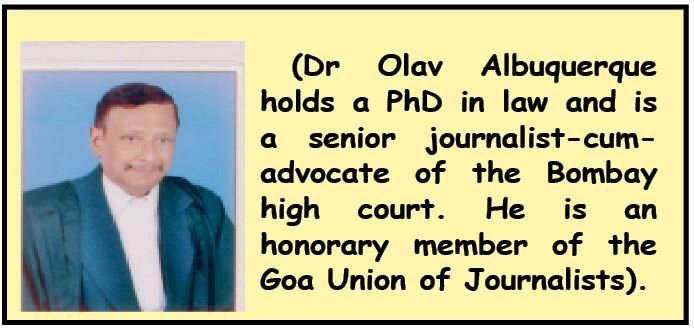THE golden bell at Se Cathedral Church in Old Goa, which had not been functioning for the last 18 months, was temporarily repaired by the locals on April 22 because it had become a dysfunctional relic — because the “Askewed” Society of India, Archaeological Survey of India itself, may have allegedly metamorphosed it into a relic. The ASI is supposed to do the work of preserving old monuments, something which it hardly does. For the sake of clarity, the bell was made of brass and not of gold, but its gleaming exterior gives it the appearance of being a gold bell.
The golden bell at St Catherine’s Cathedral in Goa weighs over 2,000 kilograms. It is a Portuguese cast bell dating back to 1597 and is known for its intricate engravings and craftsmanship. The bell was cast in 1597 and is believed to have been brought to Goa from Portugal. The tolling of the bell resonates for over 3 kilometres.
Villagers from the vicinity gathered together and, led by an enterprising person, wrote to the local conservation head of the ASI, called Reddy. They lodged their complaint to the ASI and demanded immediate action, failing which they said the ASI should immediately vacate their posts and leave Goa.
NO MOURNING
THIS golden bell was not functioning for over 18 months. After the death of Pope Francis, it was noticed that the traditional bell ringing to mourn the demise of the head of the Catholic Church did not take place after the circular required all the churches and chapels to do so. The ASI has shortcomings, including understaffing, inadequate funding, no specific guidelines, and no communication between field teams and the administration, so the head of one department does not know exactly what the head of the other department is doing.
There are also issues with encroachment on protected sites, poor documentation of excavations, and a lack of centralized monitoring of activities. Furthermore, the ASI struggles with inconsistencies in preservation policies and a lack of proactive maintenance plans.
Staffing & Budget:
THE ASI has a significant number of vacant positions, impacting its ability to effectively manage its responsibilities. Budgetary constraints further hinder its operations, leading to a lack of resources for maintenance, exploration, and excavation.
Communication & Coordination:
THERE’S a lack of communication between field survey teams and administration, leading to inconsistencies and inefficiencies in operations.
Policy and Guidelines:
THE ASI lacks clear and consistent guidelines for preservation, leading to arbitrary conservation work and inconsistencies in how monuments are protected.
Encroachment & Damage:
A SIGNIFICANT number of ASI-protected sites have been encroached upon, and there’s evidence of damage to monuments.
Documentation & Monitoring:
DOCUMENTATION of excavation activities is often poor, and there’s a lack of centralized monitoring of activities, making it difficult to track progress and identify potential issues.
But these are only a few of the ills, which is why the misnomer the “Askewed” Society of India would better apply to this distinguished body of experts, whose expertise is sometimes provided and arguably quite often not provided to Goans and Indians by and large.
The point is that this is not the first time that the ASI has refused to discharge its official functions. In Old Goa, the ASI has kept ancient monuments such as cannons used by the Portuguese and other artefacts out in the open to be destroyed by the ravages of the heavy downpour during the monsoons. These artefacts, some of which consist of old statues and monuments, will gradually crumble into dust with the vagaries of time.
When the Portuguese invaded ancient Chandrapur, now known as Chandor, it had the Kadamba King Harihar as its ruler. The people of Chandrapur did not defend him in the battle against the Portuguese, and the king was killed. The queen was furious at her people and committed suicide. But before dying she cursed the villagers by beating her feet on a stone outside the temple and said every woman from Chandrapur would become a widow after marriage.
The huge stone with what is believed to be her footprints is still maintained and it is kept right out in the open at the front side of St Tiago Chapel at Cotta. The ASI seems to be least bothered that miscreants may either steal this ancient artefact or destroy it. Not far from this stone, with what is believed to be the footprints of the Kadamba queen, lies the severed torso of a bull which was worshipped by those who lived in its vicinity. The bull is located within a well but the ASI seems to be least bothered about extricating it from the well and relocating it to an ASI museum.
Old temple ruins close to the ancient stone which carries the footprints of the Kadamba queen have also not received any attention from the ASI. These ruins have been left to denude and fade away in with the mists of time. The historicity of Chandor will be lost forever.
After doing excavations at Cotta, an ASI official prepared a report, which has not seen the light of day because that official expired. With the advance of technology, it is shocking that the ASI does not preserve old monuments and artefacts and is unable to preserve a valuable manuscript prepared by its own officials.

